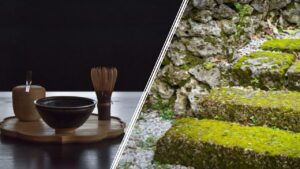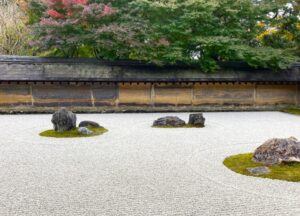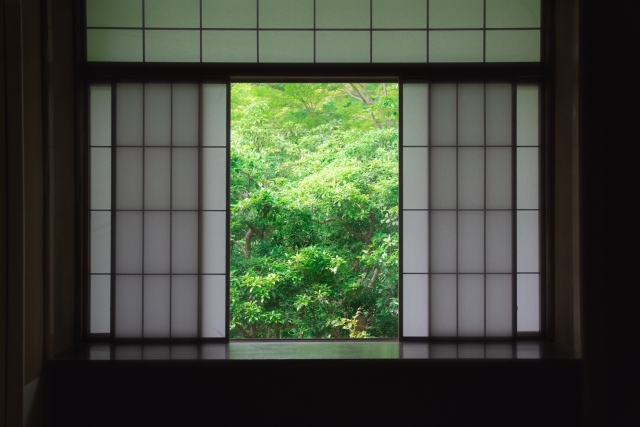Wabi-sabi — it is the quiet, profound philosophy that lies at the heart of Japanese aesthetics.
True beauty does not reside in perfection, but in imperfection.
It is not in lavishness that we are moved, but in the quiet grace of simplicity.
The fleeting nature of things, the subtle beauty that deepens with time—
there, the spirit of wabi-sabi lives.
Consider a tea bowl with a small crack, holding a single flower.
Even that crack becomes part of its charm, a trace of a story gently unfolding.
The glow of falling autumn leaves in the evening light.
The calm presence of an aged wooden temple.
Each of these reflects the spirit of wabi-sabi that lives in the Japanese heart.
The Origins of Wabi-Sabi — The Birth of Wabi-cha
The idea of wabi-sabi took shape over centuries of Japanese history.
Its essence became clear during the medieval era, in the culture of the tea ceremony.
In the Muromachi period, tea utensils imported from China—known as karamono—were highly prized.
These pieces were elegant and sophisticated, adorned with vivid glazes and exquisite craftsmanship.
They symbolized prestige and wealth among the shoguns and aristocrats.
But over time, people began to find beauty not in extravagance,
but in humble, unadorned bowls and tools—
objects that carried a quiet, human warmth.
This sensibility was perfected in Sen no Rikyū’s wabi-cha,
a style of tea that rejected ornamentation and embraced natural asymmetry and the patina of use.
Rikyū designed the tearoom to be as simple as possible,
with a small, low entrance called nijiriguchi,
inviting all who entered—regardless of rank—to bow humbly before the way of tea.
This, perhaps more than anything, embodied the aesthetic of wabi-sabi.

Tea House at Kyu-Furukawa Gardens
The Two Dimensions of Wabi and Sabi
Wabi-sabi is formed from two intertwined sensibilities: wabi and sabi.
Wabi represents a quiet, unpretentious beauty—
a serene appreciation for simplicity and modesty.
It is the warmth of an imperfect bowl, the texture of weathered wood.
Sabi, on the other hand, speaks of depth and grace that emerge with time—
the grain of an old temple pillar, the soft rust of aging metal.
It is the acceptance of change, and the reverence for what endures through it.

“Wabi” represents a sense of beauty found in simplicity and quietness, while “Sabi” conveys the depth and refined charm that emerge over the passage of time.
Together, these two elements transform wabi-sabi
from a mere aesthetic into a philosophy of life itself.
Wabi-Sabi in Everyday Life
Wabi-sabi is not limited to temples or art.
It lives quietly within the ordinary moments of our days.
The fleeting sparkle of falling cherry blossoms in spring.
A moss-covered stone resting silently in a summer garden.
The golden waves of pampas grass in the autumn dusk.
The hush of snow piling softly on a winter morning.
Its spirit also flows through Japanese architecture and gardens.
The dry landscape of karesansui, where stones and sand suggest flowing water,
captures the stillness of emptiness and form.
Even the cracked walls and aged beams of an old farmhouse
reveal the beauty of time itself.

Ryoan-ji Temple Dry Landscape Garden
Wabi-Sabi and the Modern World
At first glance, wabi-sabi seems far removed from the material abundance of modern life.
Yet its quiet wisdom speaks ever more deeply to our times.
In the simplicity of minimalism and the gentleness of slow living,
we can find echoes of the wabi-sabi spirit.
It teaches us to cherish space, silence, and the beauty of restraint—
a way of seeing that restores richness to our overfilled lives.
Today, the word Wabi-Sabi itself has crossed borders,
inspiring design, architecture, and fashion around the world.
From the imperfect to the timeworn,
the aesthetic of impermanence is being rediscovered anew.

When we open ourselves to wabi-sabi,
the familiar world begins to look different.
A chipped tea bowl, a quiet garden, a piece of weathered wood—
each brings a moment of stillness to the heart.
There is a richness in such moments that words cannot quite express.
Though born of Japanese tradition, this way of seeing is not bound by culture.
To accept imperfection, to find meaning in what fades—
this is wisdom that nourishes every human soul.
As time passes, we too gather layers of experience,
each memory and scar deepening our own beauty.
Wabi-sabi, then, is not only an aesthetic—
it is the art of seeing the quiet grace of life itself.
It is a philosophy that transcends time and borders,
whispering softly of a beauty that endures within impermanence.




コメント